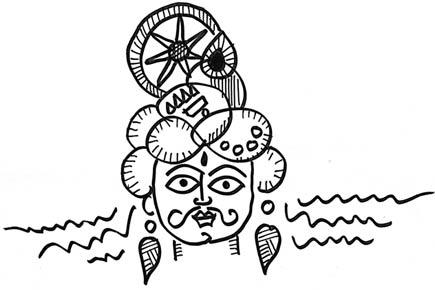As a child, like most children, I read about Ashoka in an Amar Chitra Katha comic. I assumed that was ‘the’ truth.

 As a child, like most children, I read about Ashoka in an Amar Chitra Katha comic. I assumed that was ‘the’ truth.
As a child, like most children, I read about Ashoka in an Amar Chitra Katha comic. I assumed that was ‘the’ truth.
A handsome dashing soldier, muscular and lean, who killed his brothers to be king, had a Buddhist wife, and after seeing the carnage of Kalinga perpetrated by his forces, converted to Buddhism and spread the Buddhist message around the world.

Illustration/Devdutt Pattanaik
Then, as a teen, I saw Ashoka in Shyam Bengal’s Discovery of India. Here Ashoka had two wives one Hindu and the other Buddhist and he had to politically manage manipulative Brahmins and gentle Buddhists. As an adult, I saw Shah Rukh Khan as Ashoka, who falls in love with Karuvaki, the princess of Kalinga. Now, in teleserials, I see Ashoka once again a boy mentored by Chanakya, who is supposed to have mentored his grandfather, Chandragupta Maurya!
What is the truth? What is fact? As you go deep into the subject you realise what you are told about this king is more fiction, than fact.
The undisputable fact is that a king called Devapiya and Piyadasi (Beloved of the gods, who loves everyone) Ashoka of the Maurya clan established 33 rock edicts across the Indian subcontinent 2,300 hundred years ago. He had a queen called Karuvaki and a son called Tivara. He experienced great remorse following the war at Kalinga. He was influenced by Buddhism. He respected all faiths and sought to be a benevolent pacifist paternalist ruler.
More information comes from a Sanskrit text, dated 2nd century, called Ashokavadana that speaks of how Ashoka, a cruel monster of a king eventually became a patron of Buddhism. Information also comes from Pali texts, Mahavamsa and Dvipavamsa, from Sri Lanka, that speak of the missionary activities of Ashoka’s children, the monk Mahenda and the nun, Sanghamitra.
This information led HG Wells in the 1920s to describe Ashoka as the ‘greatest of kings’ in the short history of the world. Wells is famous for his science fiction works like ‘War of the Worlds’. HG Wells’ impression of Ashoka inspired Nehru to use Ashokan symbols, like the wheel and the lion, for the new Indian republic. Nehru even called his daughter, Indira, Priyadarshini, based on Ashoka’s titles.
However, when we go deeper, ideas emerge that make us question what we know. For example, why did Ashoka write about his remorse at the Kalinga war not in Odisha, where the battle took place, but in Girnar in Gujarat? Was it simply royal propaganda? Ashokavadana describes him not as handsome hunk, but as having bad skin and punishing courtesans who mocked his ugliness. The text does not refer to the Mauryas nor the Kalinga war at all, but to his much loved torture chamber, and attributes Ashoka’s conversion to a Buddhist monk called Samudra. It speaks of violent prosecution of Jains and Ajivikas, who were rivals of the Buddhists. There is no mention of Mahendra or Sanghamitta or Tivara.
As you study these texts and the edicts, you realise that history is often a historian’s assumption of what the past was based on a whole bunch of textual, archeological and epigraphic facts. This assumption is influenced by the historian’s own prejudice. We want to believe HG Well’s imagination. It suits many political ends. But is it really true?
The author writes and lectures on relevance of mythology in modern times, and can be reached at devdutt@devdutt.com. The views expressed in this column are the individual’s and don’t represent those of the paper.
 Subscribe today by clicking the link and stay updated with the latest news!" Click here!
Subscribe today by clicking the link and stay updated with the latest news!" Click here!









